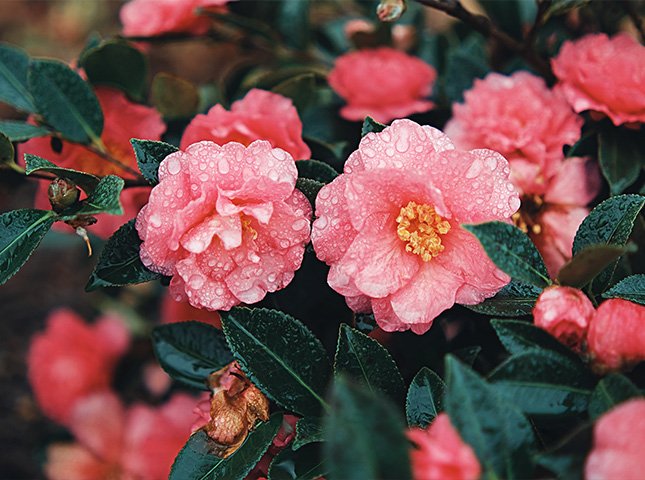Deer and camellias may live together peacefully. But do deer eat these floral beauties? The answer is complex. It depends on the area, the availability of other food sources, and the deer’s individual preferences. Camellias, with their gorgeous leaves and blossoms, can be tempting to deer. However, their taste for camellias varies from one deer to another.
Camellias are part of the Theaceae family. They come in different shapes and colors. Some deer love them, while others show no interest. This is because deer have different eating habits. Some focus mainly on grasses or shrubs than flowers like camellias.
To save your camellias from deer, try these ideas:
- Install fences or netting around your garden.
- Use repellents with natural odors, such as garlic or predator urine. These smells mimic threats and scare deer away.
- Plant companion plants that repel deer or have vegetation that deer don’t like near your camellia garden. For example, add lavender or rosemary near your camellia garden. Their strong scents will keep deer away.
Table of Contents
How to prevent deer from eating camellias
Camellias are beautiful blooms that can brighten any garden. But, if you live in a deer-populated area, these graceful creatures may have a taste for your camellias.
Preventing deer from eating them can be a task, yet, with the right techniques, you can appreciate your flowers without worry.
- Make physical barriers: An effective method to keep deer from eating your camellias is by making physical barriers around them. Fencing and netting are some options. The barrier should be 8 feet tall and buried 6 inches down, so the deer won’t jump or dig under it. Plus, check that the mesh size is small enough to stop them from reaching the petals and leaves.
- Use deterrents: Another way is to use deterrents that make your camellias less desirable to deer. There are commercial repellents or homemade solutions like garlic, peppermint oil, or soap shavings around the plants. These smells will mask the scent of the camellias and avert the deer from coming near.
- Plant deer-resistant varieties: Also, consider planting camellia varieties that are known to be less tasty to deer. Although no plant can guarantee 100% protection, certain types have shown more resistance than others. Look for varieties like ‘Survivor’, ‘Winter’s Star’, or ‘April Blush’ which have been reported to be less attractive to deer.
These strategies may not provide total protection against wildlife; however, they can significantly reduce the chances of your camellias becoming deer food. Plus, people in rural areas where camellias grow abundantly, have come up with creative ways to protect their flowers. Such as, motion-activated sprinklers or installing motion sensor lights to scare the deer and stop them from approaching. These solutions show the determination of people to coexist with wildlife while preserving the beauty of their gardens.
Other considerations when dealing with deer and camellias
When it comes to keeping deer away from camellias, there are some key points to ponder. Here are ways to protect your beloved blooms:
- Deer love camellias, especially in winter when other sources of food are scarce.
- Repellents or sprays with a strong odor or taste can be used to keep deer away.
- Fences and cages make good physical barriers.
- Regularly check for signs of deer activity, such as plant damage or tracks in the soil.
- Planting deer-resistant plants alongside the camellias can also help.
Some camellia varieties may be more attractive to deer. Research and select ones that are less appealing to them. Doing this will increase the chances of preserving the beauty of your garden.
It’s essential to take these precautions seriously. Utilizing protective measures and being vigilant will keep your flowers safe from deer. Don’t miss out on the joy of camellias – create a secure haven for them now!
Conclusion
It is clear: deer love camellias. These flowers, beloved by gardeners, are seen as treats by the majestic creatures. Not only do they eat camellias, but also a wide range of shrubs and trees. However, deer tend to target camellias more in times of food scarcity, such as winter or drought. So it’s important to take precautions.
History reveals that deer were possibly drawn to camellias due to their fragrances and colors. Ancient East Asian cultures believed these blooms symbolized love and devotion, and even had mystical powers.
Frequently Asked Questions
Q: Do deer eat camellias?
A: Yes, deer are known to eat camellias. Camellias are often attractive to deer due to their tender leaves and flowers.
Q: How can I protect my camellias from deer?
A: There are several methods you can try to protect your camellias from deer. These include using deer repellents, installing fencing, planting deer-resistant plants nearby, or using motion-activated sprinklers to scare off the deer.
Q: Are there any camellia varieties that deer are less likely to eat?
A: While there is no guarantee, deer tend to avoid camellia varieties with more fragrant flowers, as they are less appealing to them. Some examples include Camellia sasanqua ‘Yuletide’ and Camellia japonica ‘April Tryst’.
Q: Can deer cause serious damage to camellias?
A: Yes, deer can cause significant damage to camellias by browsing on the leaves and flowers. This can result in stunted growth, distorted leaves, and reduced blooming.
Q: When are camellias most vulnerable to deer damage?
A: Camellias are most vulnerable to deer damage during the winter months when other food sources are scarce. However, deer may still feed on camellias throughout the year if they are hungry.
Q: Are there any natural deterrents that can help keep deer away from camellias?
A: Some natural deterrents that may help keep deer away from camellias include planting strong-smelling herbs like lavender or rosemary nearby, using garlic or onion sprays, or hanging bars of strongly scented soap in the vicinity.


